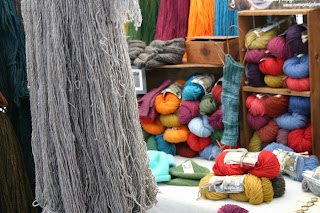 Wow. Let me say that again. WOW! What a weekend! As a first time vendor at the Common Ground Fair let me just say ..it was all I could hope for and more. The GREATEST folks on the planet run the Fiber Marketplace and I sincerely mean that!
Wow. Let me say that again. WOW! What a weekend! As a first time vendor at the Common Ground Fair let me just say ..it was all I could hope for and more. The GREATEST folks on the planet run the Fiber Marketplace and I sincerely mean that! 
 Wow. Let me say that again. WOW! What a weekend! As a first time vendor at the Common Ground Fair let me just say ..it was all I could hope for and more. The GREATEST folks on the planet run the Fiber Marketplace and I sincerely mean that!
Wow. Let me say that again. WOW! What a weekend! As a first time vendor at the Common Ground Fair let me just say ..it was all I could hope for and more. The GREATEST folks on the planet run the Fiber Marketplace and I sincerely mean that! 
 Once the yarn has been rinsed free from the spinning oil, I prepare my dye. The yarn is then weighed and my personal dyeing process begins.
Once the yarn has been rinsed free from the spinning oil, I prepare my dye. The yarn is then weighed and my personal dyeing process begins.
The paper towel will be a good indicator of the pigment left in the water. This water, from Peacock Blue dye, is almost clear, but does not appear to be in the jar. The fibers of the paper towel do not absorb much color, and when rinsed holds no color at all.
The water in the pot will be lowered, BUT you do not have to dump all of that water down the drain. It is still quite warm and ready to be reheated. Fill up your pot to the "fill line" that you usually use, and add whatever mordant ( if you use one) you might need. ( This picture is deceiving, as I only add about an inch to the fill line). Put the pot back on the stove, cover, and reheat the water. It should take very little time to be hot enough to add your new color.
Now, this is where you need to think out your next move. We all are familiar with the color wheel and what colors we can combine to make other colors.
In this pot I used Peacock Blue, a bright, "turquoisey" blue with green and gold tones. Because there is a slight bit of pigment in the pot. My safest choices of color to add next are in that family of colors. So a blue or green will work perfectly. If I were dyeing yellow, I might next change to shades of golds and oranges. Reds pretty much need to stay in the red family, as do purples.
This whole process is trial and error. Again, my methods will never be the same as yours. I usually try and run through 4 dyelots before I change the water. I figure that I save around 20 gallons of water per 4 dyelots using this method. So .... less water = less fuel to heat it. Rinsing the yarns in cold water saves fuel as well. Be sure and put covers on your pots when heating your water each time. The wide, open pots loose as much as 50% of the heat out of the top.
NEXT : SOLAR DRYING